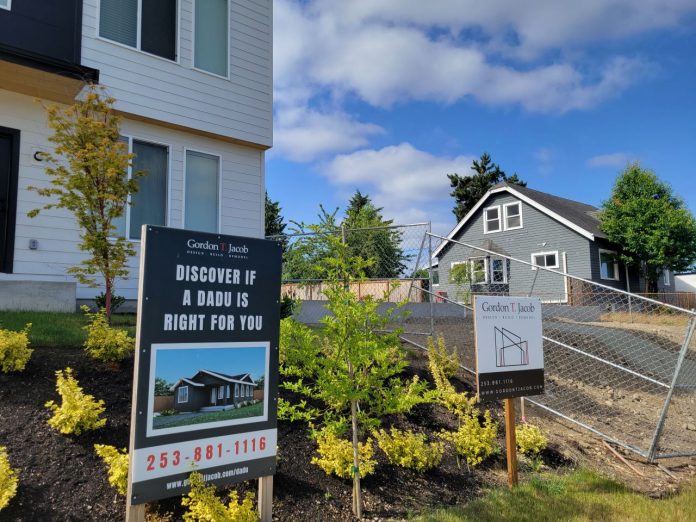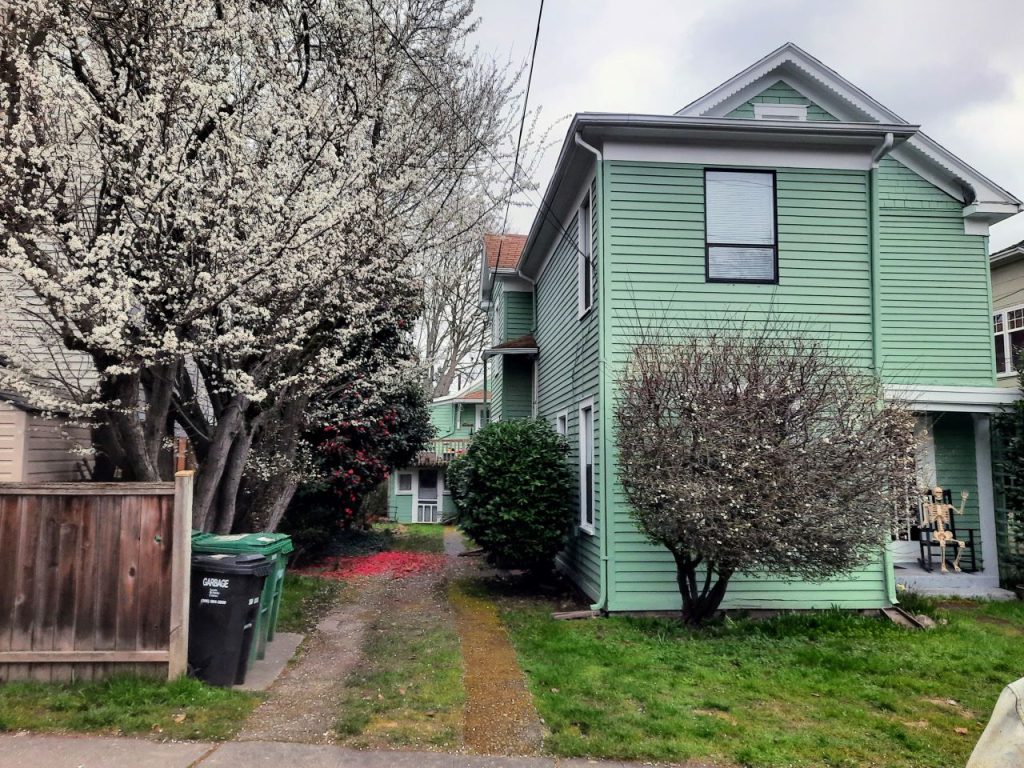
The Washington State Building Code Council is considering changes to the state’s fire code proposed by the Washington Association of Fire Marshals that would require five-foot wide pathways on lots with two or more dwellings. The proposed rule change is meant to address the proliferation of accessory dwelling units (ADUs) across the state and what the fire marshals contend is a trend in access pathways as narrow as three or four feet wide.
The fire marshals claim these narrow pathways make access by first responders with gurneys or fire ladders more difficult. But developers and housing advocates say increasing the standard won’t necessarily increase safety and will result in higher housing costs.
The Washington State Legislature enacted statewide ADU reform in a 2023 bill that recently went into effect for many jurisdictions, including Seattle. The reform generally requires that urban jurisdictions allow two ADUs per lot, and it bars a number of onerous building requirements, including off-street parking mandates within a quarter mile of a major transit stop. The lawmakers’ intent was clearly to encourage homebuilding in single family zones — which could be at odds with the recent fire marshals’ push.
The fire marshals’ association filed for an emergency change to the state’s building code that would mandate a five-foot wide pathway to any dwelling that doesn’t face a street, alley, or parking lot.
After listening to debate from both sides of the issue, the building code council voted in August against the emergency rule change, but instead referred the issue to a subcommittee that will investigate the issue further and make a decision at a later date.
Dave Kokot, former president of Washington State Association of Fire Marshals, who filed the request and spoke during the council debate, said that his organization is concerned about an increasing number of properties with three-foot-wide access paths, especially those with detached accessory dwelling units (DADUs) or backyard cottages, in common parlance.
“What concerns us is our access for both medical and for fire response,” Kokot said. “If we have that three-foot width, it’s not wide enough to properly get a gurney out. If there is a medical issue, having to do compressions or some other medical services, what we found is we need at least four feet of width.”
In the amendment proposal submitted to the council, the fire marshals proposed that the five-foot-wide access could be reduced to four feet if an ADU is equipped with a sprinkler system.
“Emergency responders are seeing a problem with one section of the Fire Code that has not been an issue until the recent ‘housing crisis’ has pushed development of more than 2 dwelling units on a single family residential parcel,” the fire marshals wrote in their proposal.
Patrick Hanks, code and policy manager for the Building Industry Association Washington (BIAW) said developers are concerned about the proposed code changes. “We’re not opposed to fire safety measures, but we try to find a balance of what’s the most cost effective fire safety thing we can do to address a particular problem while still allowing for affordable construction.”
In a state that needs one million more homes in the next 20 years to address its affordability crisis, Hanks says that the proposed changes won’t make a significant difference in safety but will continue to contribute to rising housing costs.
“As I’ve spoken with builders, the feedback on the ground is that affordable housing faces a death by a thousand cuts with every little rule, regulation, and fee that can be used by local jurisdictions that are anti-growth to stop or discourage building more homes,” Hanks said.
Kokot insists the five-foot passage is necessary, not only for stretchers and first responders but as a space to prop up fire ladders.
“We have to get a ladder up to that rooftop,” Kokot said. “And with a three foot width, with a tall ladder coming up there, it gets to the point where we actually cannot climb the ladder safely without somebody holding the ladder to be able to get something up onto the roof.”
“Often when new things are introduced, whether that’s ADUs or single-stair buildings, there’s a higher level of scrutiny against them compared to the base code,” said Stephen Smith, director of the Center for Building in North America, which conducts research on how building codes impact housing construction and affordability. Smith questions why Washington’s fire marshals are insisting they need five feet of access to ADUs when code allows for three-foot wide hallways and stairways for townhouses and apartment buildings.
“Firefighters will tell you: well, actually three feet isn’t enough. We need more,” Smith said. “But if you take a step back, you realize, well, you don’t get five feet in other situations.”

Michael Eliason, a Seattle architect who has advocated for reforming outdated building codes that require features such as second staircases that don’t actually increase fire safety, said that the proposed changes seem like overkill.
“Our [state’s] building codes are incredibly lengthy and complex,” Eliason said. “Our building costs are some of the highest in the country, and I think that this does a real disservice to trying to address housing affordability.”
Asked for evidence that three-foot access paths to ADUs increase fire risk or decrease safety, Kokot said he has no firm data on the difference.
“Nothing has been tracked on that. What I hear is hearsay. I’ve heard that we have run into issues on site-specific cases,” he said.
Kokot, who once worked as a fire protection engineer for the Spokane Fire Department, said that in Spokane, the Tri-Cities, and in some Western Washington cities, houses built in the 1940s and 1950s were constructed closer together than previously, and getting ladders up to the roof in those narrow spaces is difficult. “There’s a recommended dimension for the ladders, and we’re already going past that. And that does delay and hamper our efforts as a fire service to be able to respond to a fire.”
A cost analysis that Kokot provided to the building code council asserts that the cost of the new regulations would be minimal. The fire marshal organization claims that an additional 200 square-foot paved sidewalk on any property with an ADU or DADU would only cost from $1,600 to $2,400 — or less than 1% of the budget on most developments.
“What I did was assume that we had a three-foot width for basic concrete,” Kokot said, “and the cost analysis was based on the average length that you would have on a walkway of going from three feet to five feet for concrete. It really isn’t very much of a cost.”
Hanks, with BIAW, disagrees with this analysis.
“If it requires you to have a five-foot concrete pathway, then yeah, that’s going to have a lot of cost,” he said. “And if, in order to meet the lower size requirement [of four foot width] and then put in a fire sprinkler, that’s going to increase cost. But a lot of the cost comes from indirect consequences. It may make it less suitable, you might not be able to fit it in the property.”
Eliason agrees that an indirect impact might be that fewer ADUs or DADUs will be built because of the more stringent pathway requirements. “Construction is one thing, feasibility is another,” he said. “Maybe they can’t do an ADU, or it becomes smaller and it doesn’t become cost-effective at some point.”
Smith notes that many jurisdictions across North America allow three-foot access pathways in their ADU code requirements, including San Francisco. He feels the fire marshals’ approach is often based on conjecture rather than evidence. “I would question, if you have sprinklers, for example, why is the requirement four feet, and not three feet, like an apartment building?”
Kokot said that he’s skeptical, in general, of efforts to add ADUs and DADUs in cities like Spokane, where the city is adjusting its code to allow for more units on a lot and to comply with a 2023 state law requiring cities to allow ADUs.
“We’re trying to cram an awful lot into a single family lot that was originally plotted and laid out to be for a single home,” Kokot said. “Another thing that’s a concern for us is that they no longer require parking on these lots as well. So that means there are more cars out on the street and we can’t get our fire trucks to the buildings as well.”
The idea of requiring excessive off-street parking in order to maybe present a clearer path for fire trucks in the case of emergency is likely to rub urbanists the wrong way. Smith thinks such thinking is typical of an outdated approach by many fire safety officials.
“There’s a general discomfort in the fire and building code worlds with density,” Smith said. “And some of it is rooted specifically in technical issues. But I think some of it is a general cultural gulf between the building and fire safety worlds.”
Matt Hutchins, a Seattle-based architect who does a lot of work designing ADUs and DADUs, said the proposed state code changes won’t impact Seattle very much because it already effectively requires a five-foot wide buffer around them – though not completely paved. Seattle is also unique in that it’s the only city in the state with a completely separate building code, though it relies heavily on recommendations from the state.
“It’s somewhat superfluous in that we already require, for the most part, that a detached accessory unit going in has to be five feet away from other buildings,” Hutchins said. “And they also can’t be within five feet of a side yard setback. So, you’re kind of already guaranteed access on at least two sides.”
The Urbanist reached out to Seattle Fire Department spokesperson Kristin Hanson, who declined to comment on the specifics of proposed rule changes.
“The Seattle Fire Department is aware that a special committee will most likely be stood up by the State Building Code Council to review this proposal,” Hanson said. “We can’t comment on that work and any resulting code amendments until proposals are developed. The Seattle Fire Department will, as always, monitor and provide input to ensure adequate access and egress is maintained for life safety purposes.”
Hutchins laments that fire safety officials in the U.S. tend to err on the side of being overly cautious, even if there’s no evidence showing their approach actually increases safety or reduces response times. He notes that in Europe, for instance, elevators are sized to fit a wheelchair rather than a full gurney as is required by code in the U.S.
“European apartment elevators and others all around the world can be much smaller because they allow for somebody to sit in a wheelchair,” Hutchins said. “And so this little building code wrinkle, to accommodate for extremely rare events, is driving the entire industry towards a less-efficient use of space.”
Smith concurs, noting that “fire and building officials don’t want to hear anything about another country. It’s of zero interest to them. They write it off very quickly.”
If fewer new units are permitted and built because of restrictions, that leaves most residents living in older buildings with lower safety standards, Smith pointed out.
“We’re not always great at balancing the various kinds of benefits,” he said. “Because new buildings are much safer than old buildings. So if you make it harder to build a new building, you are actually decreasing fire safety.”
Correction: The initial draft said the change would apply to single family lots with more than two dwellings. Actually it appears to apply to all single family lots with multiple dwellings. This was corrected at 1pm Tuesday.

Andrew Engelson
Andrew Engelson is an award-winning freelance journalist and editor with over 20 years of experience. Most recently serving as News Director/Deputy Assistant at the South Seattle Emerald, Andrew was also the founder and editor of Cascadia Magazine. His journalism, essays, and writing have appeared in the South Seattle Emerald, The Stranger, Crosscut, Real Change, Seattle Weekly, the Seattle Post-Intelligencer, the Seattle Times, Washington Trails, and many other publications. He’s passionate about narrative journalism on a range of topics, including the environment, climate change, social justice, arts, culture, and science. He’s the winner of several first place awards from the Western Washington Chapter of the Society of Professional Journalists.
